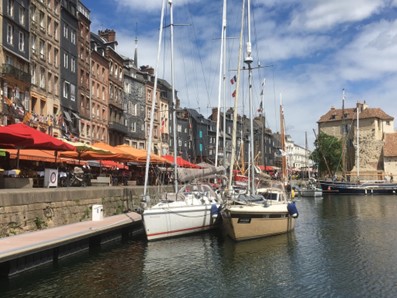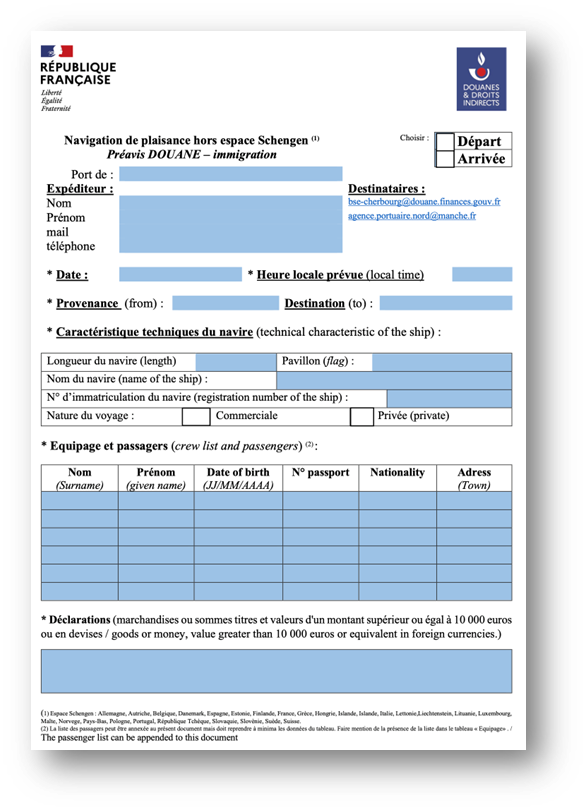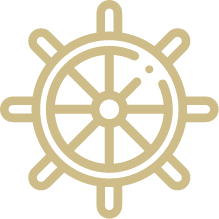
- Blog
-
by Pete Green
How much has really changed?
Crossing the channel before the pandemic and Brexit may have seemed a lot simpler but many of the current regulations existed back then. Before Brexit you still had to fill out and post a form, fly the “Q” flag and call yacht line on the way back.
Now the UK is out of Europe and Covid restrictions are relaxed, skippers and customs officials are finding their way through the red tape. Initially, ports of entry were limited to main ferry ports with horror stories of bureaucracy. Anecdotally since Brexit more Brits are cruising at home and so are the French. Recently however, more ports are becoming available and processes simplified for which we should thank the Cruising Association for their lobbying.
UK Border Force has launched an improved online reporting system and the EU are about to launch an electronic entry system and pre-travel authorisation that should further streamline. Has it actually got easier? Well, probably not if you want to cruise the Med for more than 3 months out of 6 or sail from Normandy to Brittany via the Channel Islands!
Political and economic area definitions
It is worth starting with some geographic definitions as they are used in many regulations. The United Kingdom (UK) comprises Great Britain (England, Scotland & Wales) and Northern Ireland. Great Britain (GB) includes islands such as the Isle of Wight and the Isles of Scilly but not the Isle of Man nor the Channel Islands.
The Channel Islands are not part of the UK, nor are they commonwealth countries or British Overseas Territories and they have never been part of the EU. Along with the Isle of Man, the Bailiwick of Guernsey (which includes Alderney, Sark & Herm) and the Bailiwick of Jersey are self-governing Crown Dependencies. As a side note, the beautiful Chausey Islands south of Jersey are under the jurisdiction of continental Normandy in France.
The Common Travel Area (CTA) links the UK, Crown Dependencies and Ireland that pre-dates both British and Irish membership of the EU and is not dependent on it.
The European Union (EU) is a political and economic union of 27 member states which includes the Republic of Ireland and all cross-channel mainland destinations. The European Economic Area (EEA) is a commercial treaty that includes EU member states and three EFTA states (Iceland, Liechtenstein, and Norway). The UK left the EU (and the EEA) on 31st January 2020 under Brexit.
The Schengen area is a passport-free zone across 27 European countries (including 23 of the 27 EU states). The area includes cross-channel cruising destinations France, Belgium, Netherlands and wider destinations Spain, Portugal, Germany, Denmark and Sweden. Of note for cruising, Norway and Iceland are non-EU countries in the Schengen Area and Ireland is an EU country that is not part of the Schengen Area.
UK Border Force and Reportable Voyages
The UK Border Force (BF) was established in 2012 as part of the Home Office combining the border control responsibilities of HMRC, HMCE, immigration and visa agencies. Border Force requires you to report pleasure craft voyages in and out of the country to HMRC.
If your pleasure craft is leaving Great Britain (England, Scotland and Wales) to go anywhere other than Northern Ireland you are required to tell HMRC. If you are leaving Northern Island to go anywhere other than GB or EU countries you must also tell HMRC. These two statements do leave an interesting potential loophole in that you could sail to Northern Ireland then on a separate voyage sail from Northern Ireland to the EU without having to report!
There is no requirement to report voyages between GB, the Isle of Man and Northern Ireland. Likewise, there are no requirements to report voyages to and from GB islands such as the Isle of Wight and the Isles of Scilly however you do need to report going to the Channel Islands and any EU country.
Sailing to and from Great Britain
The regulations for leaving and returning back to GB are fairly straightforward. For cross-channel, if you are heading to or returning from an EU country or the Channel Islands you must inform HMRC.
There are currently three systems to choose from, the original C1331 paper form, a spreadsheet version e-C1331 or the new online sPCR (submit a pleasure craft report). Whichever you use you still need to submit before you leave and when you get back.

The old “C1331” form is a downloadable PDF which has 2 parts. You print, fill in and post part 1 to UK Border Force before you leave the UK. On the way back, you fly the “Q” flag when entering UK territorial waters, complete part 2 of the form and phone National Yachtline on 0300 123 2012 for instructions.
The “e-C1331” is a spreadsheet version named “pleasure craft report (sPCR) fall-back template”. The process is the same, but you email the spreadsheet as an XLSX file only to the relevant regional Border Force.
Lastly, the “Submit a pleasure craft report (sPCR)” is new and should replace the above. You still fly the “Q” flag on entering UK waters until you have reported arrival. To report arrival, you update the sPCR and that’s it. You only need call the National Yachtline if you posted the old C1331, can’t access sPCR or if you need to report import VAT, non-running repairs or modifications, have goods to declare or people on board who need immigration clearance.
Submit a pleasure craft report (sPCR)
The new sPCR process is still in BETA but is fully functional and simple to use. First, create a login, complete details about your vessel (including SSR registration, MMSI and call sign), then add names and passport details for the skipper and any other regular crew.
https://www.spcr.homeoffice.gov.uk
Once set up, you can draft voyage plans quickly and easily using the details saved. Plans should be submitted at least 2 hours before and no more than 24 hours before you depart. The whole process from account set-up to drafting a voyage plan is simple and straightforward and can be done in less than 15 minutes as I proved to myself today.
You can amend voyage plans online but if unavailable or in an emergency call the relevant regional Border Force listed below;
| Central | +44 (0)300 072 4322 | |
| North | +44 (0)300 104 5941 | |
| South | Bristol | +44 (0)1275 473 757 |
| Devon & Cornwall | +44 (0)300 073 9621
+44 (0)1392 366 492 +44 (0)7810 851199 |
|
| Newhaven | +44 (0)300 073 8592 | |
| Poole | +44 (0)1202 634 555
+44 (0) 7810 851199 |
|
| Portsmouth | +44 (0)7557 205 925 | |
| South/West Wales | +44 (0)300 1064 188 | |
| Southampton | +44 (0)7810 851199 | |
| South East | +44 (0)130 329 9157 |
Sailing to and from the Channel Islands
Travelling between the UK and the Channel Islands should be straightforward as both are within the Common Travel Area (CTA) and neither is in the EU. You still have to report arrival for customs but British and Irish nationals do not require permission to enter and are not subject to immigration conditions.
To enter the Bailiwick of Guernsey from the UK, the Guernsey Border Agency (GBA) requires entry via an approved port. Approved ports are Beaucette Marina, St Sampson’s Harbour and St Peter Port in Guernsey and Braye Harbour in Alderney. You can’t visit other islands such as Herm and Sark before checking. Fly a “Q” flag and complete a written hard copy GC27 “Report of Arrival for Pleasure-Craft” form. Visit www.gov.gg/vesseldeclaration for updates and to download a GC27.
For the Bailiwick of Jersey, Customs and Immigration only require clearance if coming from outside the Common Travel Area (CTA) or if you have goods or people on board to declare. You don’t need to show a passport if coming from the UK. The Jersey Marinas website still wrongly lists the UK as an EEA member and states clearance is needed if coming from outside the EEA. If you do need to declare (or are coming from France) then you should enter at the port of St Helier and fly the “Q” flag.
https://www.gov.je/travel/maritimeaviation/guidancelegislation/pages/visitingprivatevessels.aspx
Sailing to and from the Schengen Area
To enter a country as a UK tourist in the Schengen area (such as France) a visa is not needed but you do now need to “check-in” and “check out”. You can stay in the area for up to 90 days in any rolling 180-day period without a visa. For yachts cruising the Mediterranean, this has bred an industry of sailors working out the best ways to perform this “Schengen Shuffle”.
Schengen countries publish lists of official air, land and sea border crossing points. France now lists 33 ports as official sea borders with channel coast ports (east to west) being Dunkirk, Calais, Dieppe, Le Havre, Honfleur, Caen-Ouistreham, Cherbourg, Carteret, Granville, Saint-Malo, St Brieuc, and Roscoff.

The author’s previous boat (right) moored in Honfleur
In 2022 temporary dispensation was given to St Quay and St Cast to permit arrivals and departures without passports being stamped, then St Vaast, La Hougue and Barfleur were also added. It may now however be possible to check in at many other ports. A derogation was added to annex VI of the Schengen border code “A pleasure boat coming from a third country may, exceptionally, enter a port which is not a border crossing point.”.
The process requires you to seek authorisation from the non-border port who then notifies the nearest listed border crossing. You hand in a document detailing your vessel and people on board to the ports of entry and departure and keep a copy on board. There have been mixed reports of local authority knowledge of the changing regulations and the availability of both Police Aux Frontières (PAF) officers and office opening hours, however reports also suggest officials are helpful and accommodating.
It is worth checking directly with individual ports. St-Vaas currently states you can enter directly (rather than via an official port) by emailing a form to didpaf-cherbourg-cic@interieur.gouv.fr and agence.portuaire.nord@manche.fr before leaving the UK. They state Border Police may visit you in the marina if necessary to verify your passport and the procedure will also apply for departure.

Préavis immigration maritime Barneville-Carteret, Port-Bail et Dielette
The EU plans to automate border controls and replace passport stamping with an online Entry/Exit System (EES) however this has been delayed more than once and is now forecast for the end of 2023. Also planned but not yet launched is a European Travel Information and Authorisation System (ETIAS) which is reported to cost 7 Euros and will last for 3 years.
Documents & Flags
The RYA recommends you carry a core set of ship’s papers alongside passports and any other country-specific paperwork required. Vessel documents should include vessel registration, ship radio licence, insurance, proof of VAT status and a voyage log. Personal documents should include qualifications (as required by countries visiting), Short Range Certificate (SRC), passports and insurance.
UK vessels should generally fly ensigns, and on entering foreign territorial waters fly the “Q” flag. When cleared by customs the “Q” flag can be lowered and replaced by a local courtesy flag which should be flown on the starboard side and be the highest flag displayed.
Territorial Waters and the “Q” Flag
The concept of territorial water originated from cannon shot range which the British and French both set at 3 nautical miles for many centuries. After much variation caused by fishing disputes and nuclear testing, in 1982 the UN defined territorial sea as 12 nautical miles out from a low water baseline, or midway if seas overlap. This area is regarded as sovereign from the seabed to the airspace above however boats are permitted innocent passage across it.
The “Q” flag, “Quebec” signal flag or “Yellow Jack” is a plain yellow flag that was originally used to warn of disease and to request quarantine. It now signals a vessel is healthy and requests “free pratique” (clearance to enter port).
When sailing back to the UK on a reportable voyage, you are required to fly the “Q” flag from crossing the 12-mile limit until you have finished reporting to customs authorities. UK passages that go outside of territorial waters (such as across Lyme Bay) are not reportable.
The Bailiwick of Guernsey requests you fly the “Q” flag until a ‘Report of Arrival for Pleasure-Craft’ Form GC27 has been submitted or if you have goods or people to declare.
The Bailiwick of Jersey requires you to fly the “Q” flag as you enter territorial water if from outside the EEA (which includes UK) or if you have non-EEA people on board or have any goods to declare.
There are conflicting reports for sailing to France. Some sources claim you don’t need to fly the “Q” flag unless you have goods to declare or are specifically asked to although some first-hand experiences report PAF officers have instructed them to lower the “Q” flag now checked in.
Sailing with pets
Sailing cross-channel with pets can be a challenge, especially returning to GB from the EU. The good news is that, in general, there are no official health restrictions for pet dogs, cats or ferrets between the UK and the Channel Islands on a private boat and you don’t need a pet passport or vaccinations. The Jersey coastguard does however request notification before arrival via VHF channel 82 (or St Helier VTS on Channel 14).
The EU however requires dogs, cats and ferrets to be microchipped, have a health certificate for each trip (or an EU country-issued passport), be vaccinated against rabies (more than 21 days prior to travel) and dogs must have a tapeworm treatment.

Sea dogs Barnacle and Daisy
The main barrier to taking pets to France however is coming back. UK Border Force does not allow pets to be brought back into the UK on a private boat, you have to use an approved transport company and route which does includes most cross-channel ferries.
As you were
To conclude, there seems a real will from parties on both sides of the channel to find solutions to streamline processes for the benefit of sailors and tourist income. Some of the flexibilities were temporary last season and should continue but have not yet been confirmed. The UK Border Force sPCR is a big improvement but we are yet to experience if the EU’s EES and ETIAS systems will help or hinder.
Apart from those suffering the Schengen Shuffle and Returned Goods Relief on boats (that’s another story), much of the admin sailing cross-channel was already there in many ways. What hasn’t changed is the vagaries of the jet stream over the channel to pick a weather window. It’s largely as you were. Get your crew together, net off 12 hours of tide and head for your favourite bistro for moules frites. If you’d rather avoid all this and have your boat delivered then give us a shout at enquiries@halcyonyachts.com, it is our passion, and we pride ourselves on your peace of mind.

With highly qualified and experienced crew, Halcyon Yachts Ltd offers a dedicated international yacht delivery service. For more information or to see details of their recent deliveries please visit:
Disclaimer
The guidance shared in this blog was collated in April 2023 and is believed to be an accurate interpretation and a general summary of regulations at that time. Regulations may vary by individual circumstance and are subject to change. Skippers should refer to the latest local government information and should not rely on the information in this blog as legal advice.
References & Useful Information
https://www.spcr.homeoffice.gov.uk
https://www.gov.gg/vesseldeclaration
https://www.gov.je/travel/maritimeaviation/guidancelegislation/pages/visitingprivatevessels.aspx
https://www.rya.org.uk/knowledge/abroad
https://www.schengenvisainfo.com
https://home-affairs.ec.europa.eu/policies/schengen-borders-and-visa/schengen-area_en



